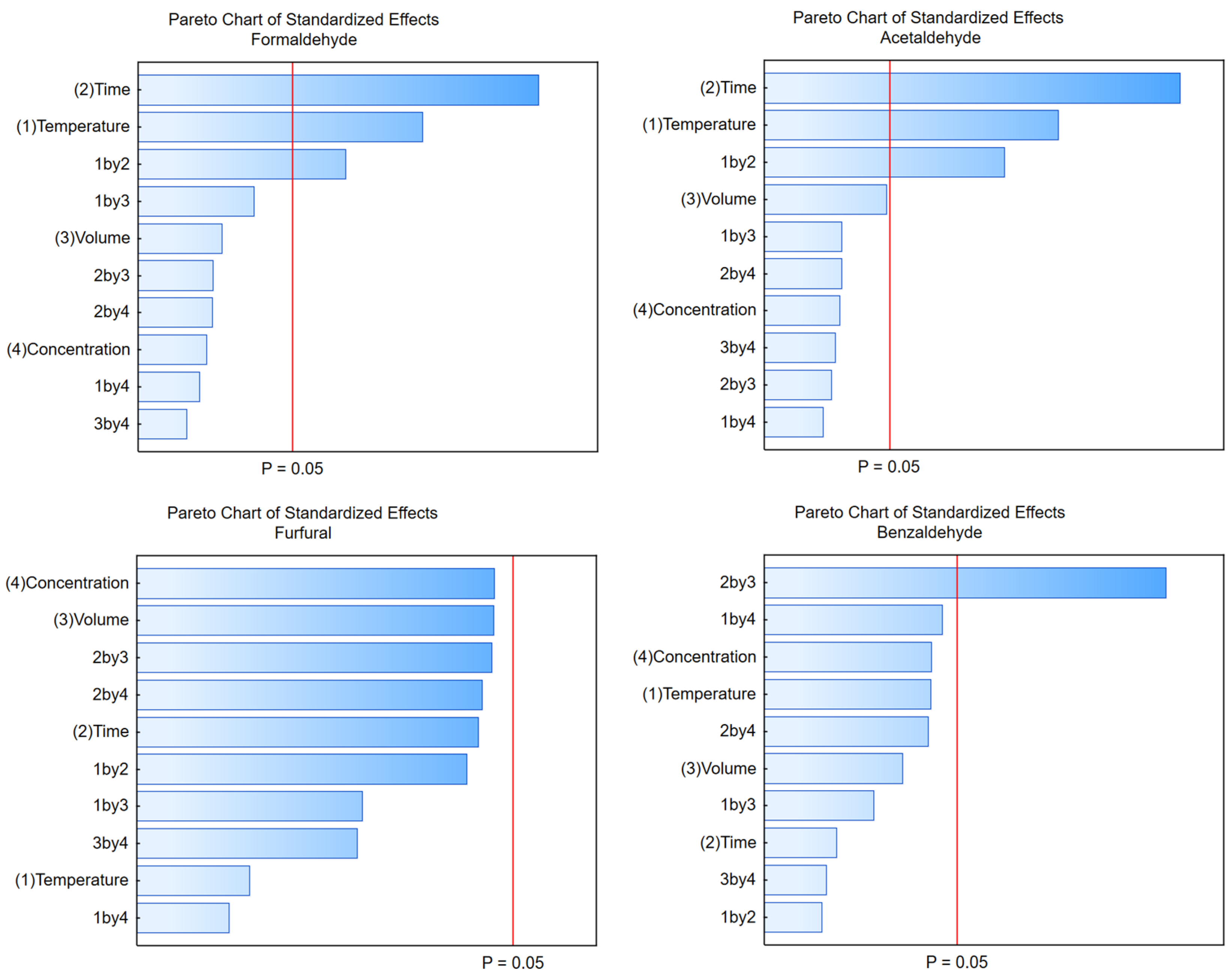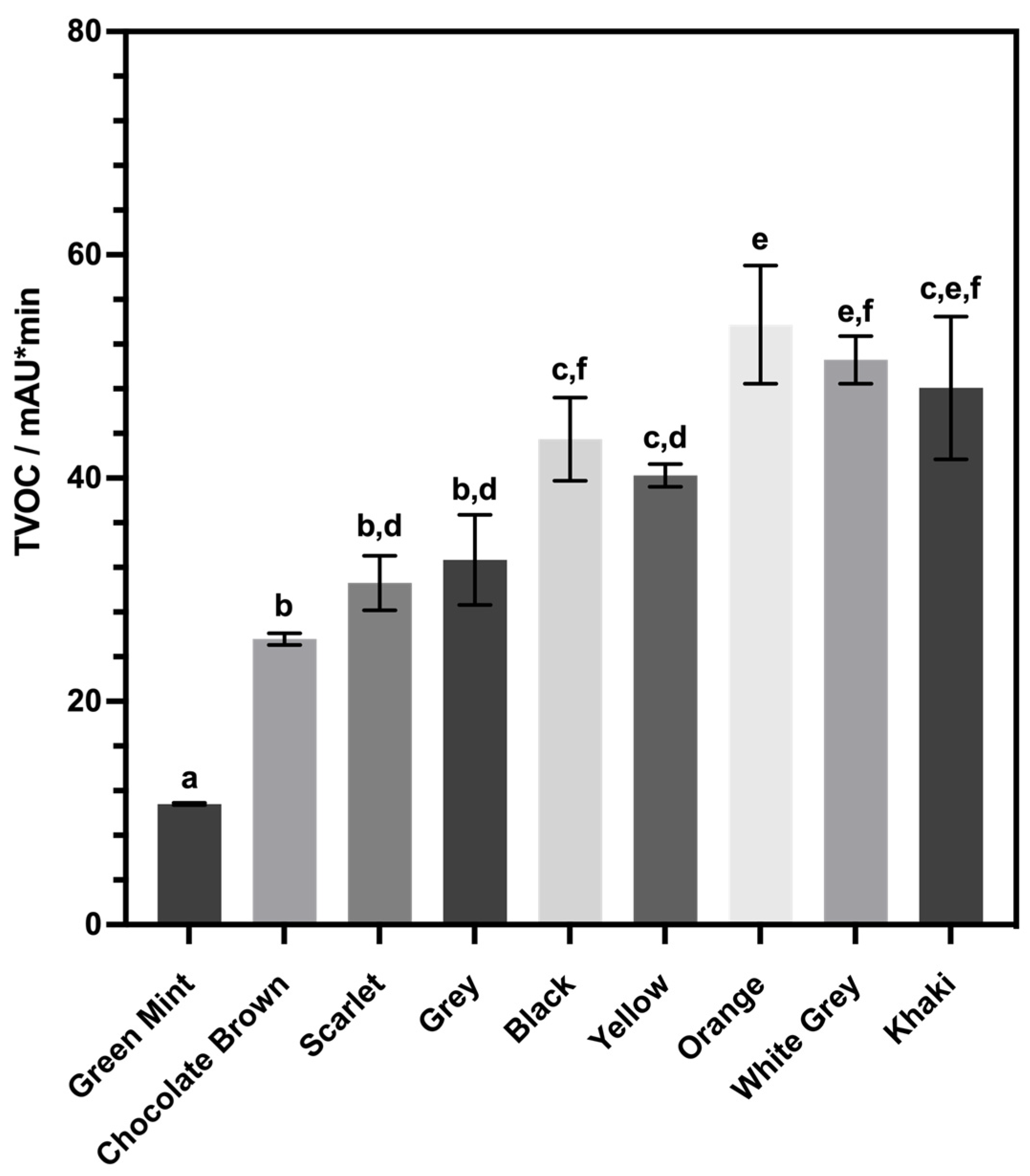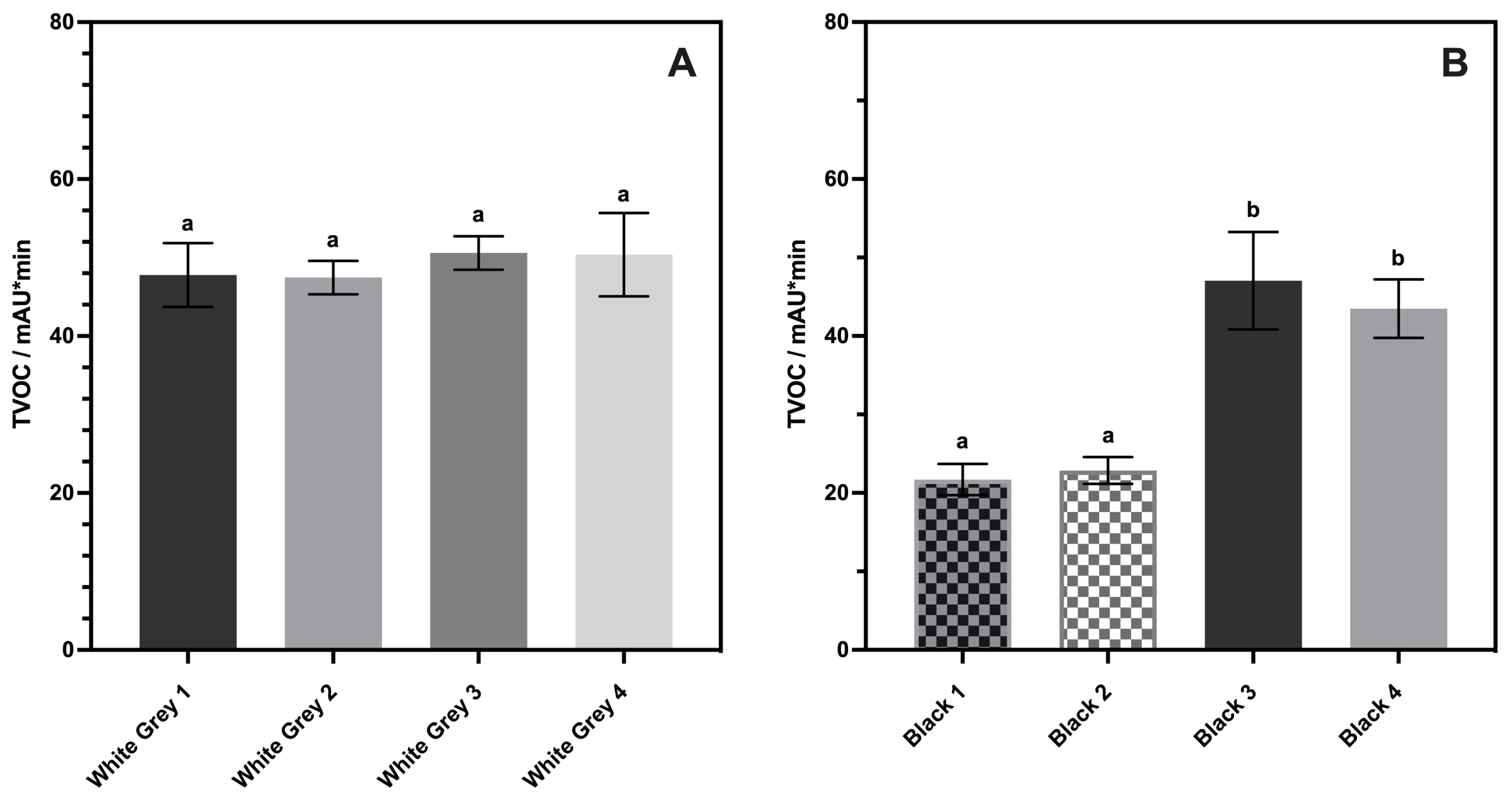Volatile Carbonyl Compounds Emission in Dry-Process Fibreboard: Identification through a Selective GDME-HPLC-DAD-MS/MS Method
Abstract
:1. Introduction
2. Materials and Methods
2.1. Chemicals
2.2. Samples
2.3. Chromatographic Analysis
2.4. GDME Procedure
2.5. Statistical Analysis
3. Results and Discussion
3.1. HPLC Method Optimization
3.2. Optimization of GDME Conditions
- The signals of formaldehyde and acetaldehyde, compounds emitted solely from the sample, showed a continuous increase in peak area when both time and temperature of extraction were increased. Therefore, no maximum was achieved.
- Results for furfural suggest that the influence of extraction time was higher than the influence of extraction temperature. The highest peak area corresponded to conditions near the centre value: 35 min of extraction time at a 30 °C temperature.
- Benzaldehyde’s and hexanal’s models showed a curvature at conditions near the centre points (45 °C and 35 min), where the peak area reached a maximum.
3.3. Analysis of Commercial MDF Samples
3.4. Identification of Volatile Carbonyl Compounds in MDF through HPLC–DAD–MS/MS
4. Conclusions
Supplementary Materials
 ), 16 mm (
), 16 mm ( ) and 19 mm (
) and 19 mm ( ). Identified compounds as DNPH derivatives: 1—DNPH; 2—formaldehyde; 3—acetaldehyde; 4—acetone; 5—furfural; 6—propanal; 7—butanal; 8—benzaldehyde; 9—pentanal; 10—hexanal; 11—heptanal; 12—octanal; 13—nonanal; Figure S2: MS/MS spectrum for the [M—H]− ion for Peaks 8, 13 and 20.
). Identified compounds as DNPH derivatives: 1—DNPH; 2—formaldehyde; 3—acetaldehyde; 4—acetone; 5—furfural; 6—propanal; 7—butanal; 8—benzaldehyde; 9—pentanal; 10—hexanal; 11—heptanal; 12—octanal; 13—nonanal; Figure S2: MS/MS spectrum for the [M—H]− ion for Peaks 8, 13 and 20.Author Contributions
Funding
Institutional Review Board Statement
Data Availability Statement
Acknowledgments
Conflicts of Interest
References
- Irle, M.; Barbu, M.C.; Niemz, P.; Carvalho, L.; Martins, J.M.S.; Costa, C.A.V.; Muszynski, L.; Launey, M.E.; Dunky, M.; Aderhold, J.; et al. Wood-Based Panels—An Introduction for Specialists; Brunel University Press: London, UK, 2010. [Google Scholar]
- Salem, M.Z.M.; Böhm, M. Understanding of formaldehyde emissions from solid wood: An overview. BioResources 2013, 8, 4775–4790. [Google Scholar] [CrossRef]
- Hemmilä, V.; Adamopoulos, S.; Karlsson, O.; Kumar, A. Development of sustainable bio-adhesives for engineered wood panels-A Review. RSC Adv. 2017, 7, 38604–38630. [Google Scholar] [CrossRef]
- Simon, V.; Uitterhaegen, E.; Robillard, A.; Ballas, S.; Véronèse, T.; Vilarem, G.; Merah, O.; Talou, T.; Evon, P. VOC and carbonyl compound emissions of a fiberboard resulting from a coriander biorefinery: Comparison with two commercial wood-based building materials. Environ. Sci. Pollut. Res. 2020, 27, 16121–16133. [Google Scholar] [CrossRef] [PubMed]
- EN 316:2009; Wood Fibre Boards. Definition, Classification and Symbols. CEN-European Committee for Standardization: Brussels, Belgium, 2009.
- Kamke, F.A. Wood: Nonstructural Panel Processes. In Encyclopedia of Materials: Science and Technology; Buschow, K.H.J., Cahn, R.W., Flemings, M.C., Ilschner, B., Kramer, E.J., Mahajan, S., Veyssière, P., Eds.; Elsevier: Oxford, UK, 2001; pp. 9673–9678. [Google Scholar]
- Gonçalves, C.; Paiva, N.T.; Ferra, J.M.; Martins, J.; Magalhães, F.; Barros-Timmons, A.; Carvalho, L. Utilization and characterization of amino resins for the production of wood-based panels with emphasis on particleboards (PB) and medium density fibreboards (MDF). A review. Holzforschung 2018, 72, 653–671. [Google Scholar] [CrossRef]
- Hagel, S.; Joy, J.; Cicala, G.; Saake, B. Recycling of Waste MDF by Steam Refining: Evaluation of Fiber and Paper Strength Properties. Waste Biomass Valorization 2021, 12, 5701–5713. [Google Scholar] [CrossRef]
- Salthammer, T.; Mentese, S.; Marutzky, R. Formaldehyde in the indoor environment. Chem. Rev. 2010, 110, 2536–2572. [Google Scholar] [CrossRef] [PubMed]
- Salthammer, T. Emerging indoor pollutants. Int. J. Hyg. Environ. Health 2020, 224, 113423. [Google Scholar] [CrossRef] [PubMed]
- Adamová, T.; Hradecký, J.; Pánek, M. Volatile organic compounds (VOCs) from wood and wood-based panels: Methods for evaluation, potential health risks, and mitigation. Polymers 2020, 12, 2289. [Google Scholar] [CrossRef]
- Formaldehyde, 2-Butoxyethanol and 1-tert-Butoxypropan-2-ol; IARC Monographs on the Evaluation of Carcinogenic Risks to Humans, Volume 88; International Agency for Research on Cancer: Lyon, France, 2006.
- Bajer, T.; Šulc, J.; Ventura, K.; Bajerová, P. Volatile compounds fingerprinting of larch tree samples for Siberian and European larch distinction. Eur. J. Wood Wood Prod. 2020, 78, 393–402. [Google Scholar] [CrossRef]
- N’Guessan, J.L.L.; Niamké, B.F.; Yao, N.J.C.; Amusant, N. Wood Extractives: Main Families, Functional Properties, Fields of Application and Interest of Wood Waste. For. Prod. J. 2023, 73, 194–208. [Google Scholar] [CrossRef]
- Baumann, M.G.D.; Lorenz, L.F.; Batterman, S.A.; Zhang, G.Z. Aldehyde emissions from particleboard and medium density fiberboard products. For. Prod. J. 2000, 50, 75–82. [Google Scholar]
- Gabriel, M.; Behn, C.; Roffael, E. Influence of fibre preparation method and wood species on the VOC-emissions from MDF boards. Int. Wood Prod. J. 2015, 6, 79–83. [Google Scholar] [CrossRef]
- Kim, G.H.; Cho, J.S.; Ra, J.B.; Park, J.Y. Volatile organic compounds emissions from radiata pine MDF as a function of pressing variables. For. Prod. J. 2006, 56, 91–95. [Google Scholar]
- Brown, S.K. Chamber Assessment of Formaldehyde and VOC Emissions from Wood-Based Panels. Indoor Air 1999, 9, 209–215. [Google Scholar] [CrossRef] [PubMed]
- Jun, S.; Qi, F.; Ohlmeyer, M.; Wang, J. Effects of the antioxidants on the aldehyde emissions from MDF made of Scots pine (Pinus sylvestris L.). J. Chem. Pharm. Res. 2014, 6, 133–138. [Google Scholar]
- ISO 16000-3:2022; Indoor Air—Part 3: Determination of Formaldehyde and Other Carbonyl Compounds in Indoor and Test Chamber Air—Active Sampling Method. International Organization for Standardization: Geneva, Switzerland, 2022.
- ISO 16000-6:2021; Indoor Air—Part 6: Determination of Organic Compounds (VVOC, VOC, SVOC) in Indoor and Test Chamber Air by Active Sampling on Sorbent Tubes, Thermal Desorption and Gas Chromatography Using MS or MS FID. International Organization for Standardization: Geneva, Switzerland, 2021.
- ISO 16000-9:2006; Indoor Air—Part 9: Determination of the Emission of Volatile Organic Compounds from Building Products and Furnishing—Emission Test Chamber Method. International Organization for Standardization: Geneva, Switzerland, 2006.
- Wajs, A.; Pranovich, A.; Reunanen, M.; Willför, S.; Holmbom, B. Headspace-SPME Analysis of the Sapwood and Heartwood of Picea Abies, Pinus Sylvestris and Larix Decidua. J. Essent. Oil Res. 2007, 19, 125–133. [Google Scholar] [CrossRef]
- Jia, L.; Chu, J.; Li, J.; Ren, J.; Huang, P.; Li, D. Formaldehyde and VOC emissions from plywood panels bonded with bio-oil phenolic resins. Environ. Pollut. 2020, 264, 114819. [Google Scholar] [CrossRef] [PubMed]
- Schumann, A.; Lenth, C.; Hasener, J.; Steckel, V. Detection of volatile organic compounds from wood-based panels by gas chromatography-field asymmetric ion mobility spectrometry (GC-FAIMS). Int. J. Ion Mobil. Spectrom. 2012, 15, 157–168. [Google Scholar] [CrossRef]
- Pacheco, J.G.; Valente, I.M.; Gonçalves, L.M.; Rodrigues, J.A.; Barros, A.A. Gas-diffusion microextraction. J. Sep. Sci. 2010, 33, 3207–3212. [Google Scholar] [CrossRef]
- Brandão, P.F.; Ramos, R.M.; Almeida, P.J.; Rodrigues, J.A. Determination of Carbonyl Compounds in Cork Agglomerates by GDME-HPLC-UV: Identification of the Extracted Compounds by HPLC-MS/MS. J. Agric. Food Chem. 2017, 65, 1037–1042. [Google Scholar] [CrossRef]
- Ferreira, R.C.; Ramos, R.M.; Gonçalves, L.M.; Almeida, P.J.; Rodrigues, J.A. Application of gas-diffusion microextraction to solid samples using the chromatographic determination of α-diketones in bread as a case study. Analyst 2015, 140, 3648–3653. [Google Scholar] [CrossRef] [PubMed]
- Brandão, P.F.; Ramos, R.M.; Valente, I.M.; Almeida, P.J.; Carro, A.M.; Lorenzo, R.A.; Rodrigues, J.A. Gas-diffusion microextraction coupled with spectrophotometry for the determination of formaldehyde in cork agglomerates. Anal. Bioanal. Chem. 2017, 409, 2885–2892. [Google Scholar] [CrossRef] [PubMed]
- Ferreira, I.M.; Carvalho, D.O.; Silva, M.G.; Guido, L.F. Gas-diffusion microextraction (GDME) combined with derivatization for assessing beer staling aldehydes: Validation and application. Foods 2021, 10, 1704. [Google Scholar] [CrossRef] [PubMed]
- Czitrom, V. One-Factor-at-a-Time versus Designed Experiments. Am. Stat. 1999, 53, 126–131. [Google Scholar] [CrossRef]
- Miller, J.N.; Miller, J.C. Statistics and Chemometrics for Analytical Chemistry, 6th ed.; Pearson Education Limited: London, UK, 2010. [Google Scholar]
- Sun, S.; Zhao, Z.; Shen, J. Effects of the manufacturing conditions on the vocs emissions of particleboard. BioResources 2020, 15, 1074–1084. [Google Scholar] [CrossRef]
- Chrobak, J.; Iłowska, J.; Chrobok, A. Formaldehyde-Free Resins for the Wood-Based Panel Industry: Alternatives to Formaldehyde and Novel Hardeners. Molecules 2022, 27, 4862. [Google Scholar] [CrossRef] [PubMed]
- Korenberg, C.; Bertolotti, G. Emissions from MDF: Governing Factors and Mitigation Strategies. Stud. Conserv. 2019, 64, 249–260. [Google Scholar] [CrossRef]
- Kölliker, S.; Oehme, M.; Dye, C. Structure elucidation of 2,4-dinitrophenylhydrazone derivatives of carbonyl compounds in ambient air by HPLC/MS and multiple MS/MS using atmospheric chemical ionization in the negative ion mode. Anal. Chem. 1998, 70, 1979–1985. [Google Scholar] [CrossRef]
- Zwiener, C.; Glauner, T.; Frimmel, F.H. Liquid Chromatography/Electrospray Ionization Tandem Mass Spectrometry and Derivatization for the Identification of Polar Carbonyl Disinfection By-Products. In Liquid Chromatography/Mass Spectrometry, MS/MS and Time of Flight MS; ACS Symposium Series; American Chemical Society: Washington, DC, USA, 2003; Volume 850, pp. 356–375. [Google Scholar]
- Santos, J.R.; Rodrigues, J.A. Characterization of volatile carbonyl compounds in defective green coffee beans using a fan assisted extraction process. Food Control 2020, 108, 106879. [Google Scholar] [CrossRef]
- Cruz, M.P.; Valente, I.M.; Gonçalves, L.M.; Rodrigues, J.A.; Barros, A.A. Application of gas-diffusion microextraction to the analysis of free and bound acetaldehyde in wines by HPLC-UV and characterization of the extracted compounds by MS/MS detection. Anal. Bioanal. Chem. 2012, 403, 1031–1037. [Google Scholar] [CrossRef]
- Schulte-Ladbeck, R.; Lindahl, R.; Levin, J.O.; Karst, U. Characterization of chemical interferences in the determination of unsaturated aldehydes using aromatic hydrazine reagents and liquid chromatography. J. Environ. Monit. 2001, 3, 306–310. [Google Scholar] [CrossRef]
- Teixeira, S.L.; Santos, J.R.; Almeida, P.J.; Rodrigues, J.A. Fan assisted extraction and HPLC-DAD-MS/MS identification of volatile carbonyl compounds as chemical descriptors of healthy and defective roasted coffee beans. Food Control 2022, 138, 109014. [Google Scholar] [CrossRef]
- Richardson, S.D.; Caughran, T.V.; Poiger, T.; Guo, Y.; Crumley, F.G. Application of DNPH Derivatization with LC/MS to the Identification of Polar Carbonyl Disinfection Byproducts in Drinking Water. Ozone Sci. Eng. 2000, 22, 653–675. [Google Scholar] [CrossRef]
- Ochs, S.D.M.; Fasciotti, M.; Netto, A.D.P. Analysis of 31 hydrazones of carbonyl compounds by RRLC-UV and RRLC-MS(/MS): A comparison of methods. J. Spectrosc. 2015, 2015, 890836. [Google Scholar] [CrossRef]
- Foyer, G.; Chanfi, B.-H.; Virieux, D.; David, G.; Caillol, S. Aromatic dialdehyde precursors from lignin derivatives for the synthesis of formaldehyde-free and high char yield phenolic resins. Eur. Polym. J. 2016, 77, 65–74. [Google Scholar] [CrossRef]
- Cantarella, M.; Cantarella, L.; Gallifuoco, A.; Spera, A.; Alfani, F. Effect of inhibitors released during steam-explosion treatment of poplar wood on subsequent enzymatic hydrolysis and SSF. Biotechnol. Prog. 2004, 20, 200–206. [Google Scholar] [CrossRef] [PubMed]





| Colour | Thickness/mm (n° Samples) |
|---|---|
| Black | 8 (1), 16 (1), 19 (4) * |
| Khaki | 19 (2) |
| Chocolate Brown | 8 (1), 16 (1), 19 (2) |
| Green Mint | 8 (1), 19 (1) |
| Grey | 8 (2) §, 12 (2), 16 (1), 19 (4) § |
| Orange | 12 (1), 16 (1), 19 (5) |
| Scarlet | 19 (3) |
| White Grey | 8 (1), 16 (1), 19 (4) |
| Yellow | 16 (1), 19 (3) |
| Factor | Low (−1) | Centre (0) | High (+1) |
|---|---|---|---|
| Temperature (°C) | 30 | 45 | 60 |
| Time (min) | 10 | 35 | 60 |
| Volume of DNPH (µL) | 250 | 500 | 750 |
| Concentration of DNPH [% (w/v)] | 0.10 | 0.20 | 0.30 |
| Compound | tR (Min) | Identified Compound | [M–H]− | Product Ions (m/z) | Standard and/or Reference |
|---|---|---|---|---|---|
| 1 | 8.49 | 1-hydroxypropan-2-one (Acetol) | 253.01 | 177, 179, 152, 151 | Standard; [37] |
| 2 | 12.34 | Formaldehyde | 208.95 | 163, 120, 151, 123, 179 | Standard; [27] |
| 3 | 15.63 | Acetaldehyde | 223.07 | 179, 178, 163, 151, 152 | Standard; [27] |
| 4 | 19.40 | Propan-2-one (Acetone) | 237.03 | 151, 179, 207, 152 | Standard; [27] |
| 5 | 20.74 | Furan-2-carbaldehyde (Furfural) | 275.05 | 228, 163, 179, 151, 111 | Standard; [27] |
| 6 | 21.09 | Propanal | 237.10 | 179, 151, 207, 163, 191 | Standard; [27] |
| 7 | 22.92 | Hydroxyheptanone * | 309.11 | 233, 152, 179, 165, 279 | [38] |
| 8 | 23.92 | 4-hydroxybenzaldehyde | 301.01 | 182, 163, 254, 137, 255 | Standard; [36] |
| 9 | 24.56 | Prop-2-enal (Acrolein) | 433.05 | 235, 223, 179, 415, 209 | Standard; [39,40] |
| 10 | 25.85 | Butanal | 251.12 | 163, 179, 205, 152 | Standard; [39] |
| 11 | 26.83 | (E)-but-2-enal (Crotonaldehyde) | 447.10 | 429, 237, 249, 179, 411 | Standard; [36] |
| 12 | 27.62 | Benzaldehyde | 285.03 | 163, 238, 121, 179, 192 | Standard; [27] |
| 13 | 29.42 | Unknown | 461.07 | 237, 223, 179, 263, 443 | [36,41] |
| 14 | 29.77 | Oxaldehyde (Glyoxal) | 417.07 | 182, 234 | Standard; [37] |
| 15 | 29.85 | Pentanal | 265.12 | 163, 179, 152, 151, 220 | Standard; [27] |
| 16 | 31.93 | Pentane-2,3-dione | 459.13 | 276, 182, 261, 279, 179 | Standard; [41] |
| 17 | 33.36 | Hexanal | 279.04 | 163, 179, 152, 153, 205 | Standard; [27] |
| 18 | 35.51 | (E)-2-heptenal | 291.15 | 163, 152, 214, 219, 244 | Standard; [38] |
| 19 | 35.88 | Butane-2,3-dione | 445.15 | 182, 399, 364, 265, 179 | Standard; [41] |
| 20 | 36.17 | aldehyde-aromatic not ortho substituted | 327.09 | 163, 280, 179, 234, 162 | [36] |
| 21 | 36.69 | Heptanal | 293.19 | 163, 179, 152, 153, 247 | Standard; [27] |
| 22 | 38.58 | (E)-oct-2-enal | 305.19 | 228, 163, 152, 258, 233 | Standard; [38] |
| 23 | 38.94 | 2,5-dihydroxybenzaldehyde * | 317.06 | 230, 270, 244, 163, 249 | [42] |
| 24 | 39.67 | Octanal | 307.13 | 163, 179, 152, 261, 153 | Standard; [27] |
| 25 | 42.40 | Nonanal | 321.13 | 163, 179, 152, 275, 157 | Standard; [43] |
| 26 | 43.95 | (E)-dec-2-enal | 333.20 | 163, 261, 152, 179, 257 | Standard; [36] |
| 27 | 44.88 | Decanal | 335.21 | 163, 289, 179, 171, 152 | Standard; [43] |
Disclaimer/Publisher’s Note: The statements, opinions and data contained in all publications are solely those of the individual author(s) and contributor(s) and not of MDPI and/or the editor(s). MDPI and/or the editor(s) disclaim responsibility for any injury to people or property resulting from any ideas, methods, instructions or products referred to in the content. |
© 2024 by the authors. Licensee MDPI, Basel, Switzerland. This article is an open access article distributed under the terms and conditions of the Creative Commons Attribution (CC BY) license (https://creativecommons.org/licenses/by/4.0/).
Share and Cite
Gonçalves, F.D.; Martins, J.M.; Carvalho, L.H.; Rodrigues, J.A.; Ramos, R.M. Volatile Carbonyl Compounds Emission in Dry-Process Fibreboard: Identification through a Selective GDME-HPLC-DAD-MS/MS Method. Separations 2024, 11, 92. https://doi.org/10.3390/separations11040092
Gonçalves FD, Martins JM, Carvalho LH, Rodrigues JA, Ramos RM. Volatile Carbonyl Compounds Emission in Dry-Process Fibreboard: Identification through a Selective GDME-HPLC-DAD-MS/MS Method. Separations. 2024; 11(4):92. https://doi.org/10.3390/separations11040092
Chicago/Turabian StyleGonçalves, Fátima Daniela, Jorge M. Martins, Luísa H. Carvalho, José António Rodrigues, and Rui Miguel Ramos. 2024. "Volatile Carbonyl Compounds Emission in Dry-Process Fibreboard: Identification through a Selective GDME-HPLC-DAD-MS/MS Method" Separations 11, no. 4: 92. https://doi.org/10.3390/separations11040092
APA StyleGonçalves, F. D., Martins, J. M., Carvalho, L. H., Rodrigues, J. A., & Ramos, R. M. (2024). Volatile Carbonyl Compounds Emission in Dry-Process Fibreboard: Identification through a Selective GDME-HPLC-DAD-MS/MS Method. Separations, 11(4), 92. https://doi.org/10.3390/separations11040092








